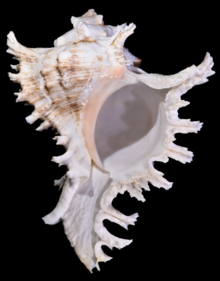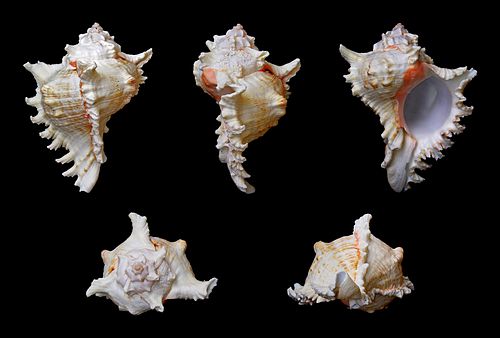- Chicoreus ramosus
-
Ramose murex 
Ventral view of a shell of Chicoreus ramosus Scientific classification Kingdom: Animalia Phylum: Mollusca Class: Gastropoda (unranked): clade Caenogastropoda
clade Hypsogastropoda
clade NeogastropodaSuperfamily: Muricoidea Family: Muricidae Subfamily: Muricinae Genus: Chicoreus Species: C. ramosus Binomial name Chicoreus ramosus
(Linnaeus, 1758)Synonyms[1] - Chicoreus (Chicoreus) ramosus (Linnaeus, 1758)
- Murex fortispinna François, 1891
- Murex frondosus sensu Martini Mørch, 1852
- Murex inflatus Lamarck, 1822
- Murex ramosus Linnaeus, 1758
- Purpura fusiformis Röding, 1798
- Purpura incarnata Röding, 1758
Chicoreus ramosus, common name the ramose murex or branched murex, is a species of predatory sea snail, a marine gastropod mollusk in the family Muricidae, the murex snails. It is considered an economically important species in the Indo-West Pacific, specially in India.[2]
Contents
Distribution
This sea snail is found widely spread in the Indo-West Pacific, and occurs from east to south Africa, including Mozambique, Tanzania, Madagascar, the Red Sea, the Gulf of Oman, Aldabra, Chagos and Mauritius. It also occurs in eastern Polynesia, southern Japan, Queensland and New Caledonia in Australia.[1][2]
Shell description
C. ramosus has a large, solid, very rugged and heavy shell, of up to 327–330 mm in length. It has a relatively globose outline, possessing a short spire, a slightly inflated body whorl, and a moderately long siphonal canal. One of its most striking ornamentations are the conspicuous, leaf-like, recurved hollow digitations. It also presents three spinose axial varices per whorl, with two elongated nodes between them. The shell is coloured white to light brown externally, with a white apperture, generally colored pink towards the inner edge the outer lip and the columella.[1][2]
Ecology
Habitat
The Ramose murex inhabits sandy and rubble bottoms near coral reefs, to depths of around 10 m.[2]
Feeding habits
As is the case in other Muricidae, C. ramosus is a carnivorous predatory species, usually feeding on bivalves and other gastropods.[2]
References
- ^ a b c Chicoreus ramosus (Linnaeus, 1758). Accessed through: World Register of Marine Species at http://www.marinespecies.org/aphia.php?p=taxdetails&id=208142 on 6 April 2010.
- ^ a b c d e Poutiers, J. M. (1998). "Gastropods". In Carpenter, K. E. & Niem, V. H.. The living marine resources of the Western Central Pacific Volume 1. Seaweeds, corals, bivalves and gastropods. FAO Species Identification Guide for Fishery Purposes. 1. Rome: FAO. pp. 562. ISBN 92-5-104052-4. ftp://ftp.fao.org/docrep/fao/009/w7191e/w7191e50.pdf.
External links
Categories:
Wikimedia Foundation. 2010.

